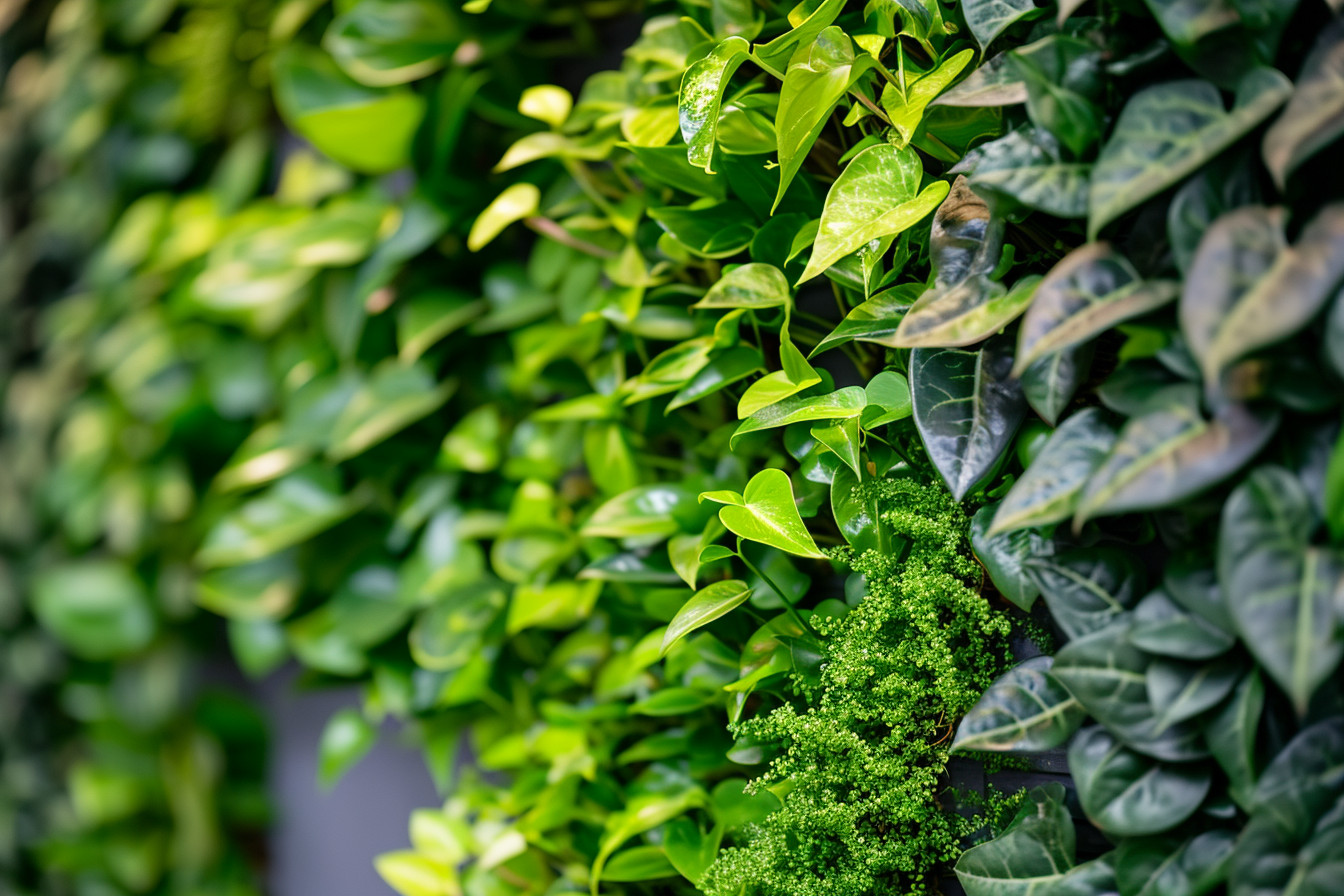Ever wandered into a lush indoor vertical garden and felt an instant wave of serenity wash over you? That’s my zen zone, where the hum of the city fades and the whispers of nature take over. But maintaining this slice of paradise isn’t all about watering and sunlight—it’s also about outsmarting those pesky pests that see your green haven as an all-you-can-eat buffet.
I’ve learned that tackling bugs in a vertical setup isn’t quite the same as in a traditional garden. There’s a bit of finesse involved, and I’m here to share the ins and outs of keeping your leafy walls as serene as they look. Trust me, with a few smart moves, you can keep those critters at bay and your garden thriving.
Identifying Common Pests in Indoor Vertical Gardens
In my years of gardening, I’ve realized there’s something quite meditative about keeping my hands in the soil and nurturing plants to life. Indoor vertical gardening has given me this peaceful escape without leaving my home. If you’re like me, finding balance amidst the greenery, it’s crucial to protect that sanctuary from unwanted critters. So let’s get down to business and identify those pesky intruders that threaten our serene green spaces.
Spider Mites: These tiny spiders are almost microscopic but don’t be fooled by their size – they can wreak havoc on your plants. The first sign is usually a subtle, silvery webbing on the undersides of leaves and, upon closer examination, you might spot the mites themselves. They thrive in warm, dry conditions, making our cozy indoor gardens a perfect home for them.
Aphids: These small sap-suckers can cause some serious damage. They tend to cluster on new growth or the undersides of leaves, and they come in a variety of colors. One of the most fascinating yet disturbing things about aphids is their quick reproduction rate.
Fungus Gnats: They might not harm plants directly, but their larvae can damage the roots, and adults are a nuisance when they swarm around your plants or face. These little flyers are attracted to moist soil, so they’re a telltale sign that I might be over-watering.
Armed with an eye for details and a bit of patience, anyone can spot these invaders. When I started, I’ll admit, it felt a bit like a treasure hunt, sifting through the leaves, searching for the culprits. Now, with experience and a little know-how, it’s become second nature.
| Pest | Appearance | Damage Signs |
|---|---|---|
| Spider Mites | Tiny, spider-like, red or yellow | Silvery webbing, yellowed leaves |
| Aphids | Small, various colors, pear-shaped | Distorted growth, sticky leaves |
| Fungus Gnats | Small, dark, mosquito-like | Swarm around plants, stunted growth |
Understanding the Impact of Pests on Vertical Gardens
As I delve deeper into the realm of indoor vertical gardening, it’s hard not to marvel at the tranquility these green spaces bring. There’s something incredibly soothing about these lush columns of greenery, a harmonious connection to nature that replenishes the soul. Yet beneath the calm exterior, an unseen battle often wages against tiny invaders – pests that seek to disrupt the balance of our carefully cultivated oases.
Pest infestations can quite literally suck the life out of plants, sometimes transforming them from abundant to withered in a surprisingly short amount of time. Understanding how these unwanted guests can impact the health and productivity of a vertical garden is paramount for maintaining its vibrancy. Let me share some of the technical yet accessible knowledge I’ve gathered about these critters and the havoc they can wreak.
Take spider mites, infamous for their fondness for indoor garden settings. These tiny arachnids can create fine webs and cause yellowing or speckled leaves, a tell-tale sign of their feeding frenzy.
But it’s not just about aesthetics – spider mites can severely stunt plant growth, or worse, lead to their demise.
Moving on to aphids, these small but mighty pests can form dense colonies, draining the vital sap from plants. The result? Stressed plants, distorted leaves, and a garden that’s anything but the green sanctuary you hoped for. Additionally, they can act as vectors for plant diseases, quite literally spreading trouble from one plant to another.
And then there are fungus gnats – more than just a nuisance. These pests gravitate towards overly moist soil, and their larvae feast on plant roots, impairing nutrient and water uptake. Weak plants and, consequently, a weak garden follow suit. We can’t let these tiny flies threaten the foundation of our towering green pillars.
While it’s disheartening to think these pests could dismantle the peace and bounty indoor vertical gardens offer, it’s empowering to learn and adopt effective management strategies. I think about the care and dedication that goes into each leaf and sprout and realize that it’s about more than just my connection to the earth. It’s about preserving a piece of serenity amidst our daily hustle – a living, breathing form of art that demands protection.
Preventing Pest Infestations in Indoor Vertical Gardens
As I’ve tended to my indoor oasis over the years, I’ve learned the tranquil peace that comes with a pest-free garden. It’s like a silent bond between the grower and the grown—a mutual respect that’s earned through diligence and care. Sprouting from that respect, I’ve honed a few preventative techniques that work wonders in keeping those pesky intruders at bay.
Regular Monitoring: It’s the first line of defense. In the tranquility of my green space, I’m always on the lookout for signs of pests. It starts with routine checks. Ever so often, I’ll gently inspect my plants, looking for the telltale signs of unwanted guests—discoloration, sticky residues, or the critters themselves. It’s a habit that’s become as calming as the gardening itself.
Climate Control: Indoor gardens need stable environments. Too damp or too warm, and it’s like rolling out the welcome mat for pests. I manage temperature and humidity with a careful hand—enough to mimic the gentle embrace of nature. Dehumidifiers and AC units aren’t just tools; they’re guardians at the gate of my garden’s serenity.
Sanitation Practices: Cleanliness might be next to godliness, but it’s certainly the neighbor of pest prevention. Fallen leaves and debris can be a party invitation to pests. A tidy space is not just visually soothing but also a stronghold against infestations. Regular cleaning and disposal of plant waste keep the peace intact.
Proper Plant Selection: I’ve observed that some plants are like sentinels, standing guard against invasion. Lavender, marigolds, and basil aren’t just aromatic delights; they’re natural deterrents. Incorporating these into the vertical canvas creates a backdrop that’s as protective as it is picturesque.
Natural Predators: Introducing beneficial insects into my garden has been a bit like matchmaking. Ladybugs, green lacewings, and predatory mites—when these little allies take up residence, pests find themselves unwelcome. There’s a delicate balance here, a dance of nature that unfolds within the walls of my home.
Natural Strategies for Pest Control in Vertical Gardens
Maintaining the tranquility of my vertical garden oasis means finding gentle but effective methods to manage those pesky intruders. Over my years of tending to indoor green spaces, I’ve gathered a wealth of knowledge on natural pest control strategies that I’d love to share with fellow enthusiasts.
Observation is my starting point; it’s the easiest and most enlightening part of my routine. Take a quiet moment every day to really look at your plants. Check for any discoloration, sticky substances, or holes in leaves—these are telltale signs of unwanted visitors. Early detection is crucial. The sooner I spot a problem, the easier it is to deal with.
Let’s talk about beneficial insects. It might seem counterintuitive to introduce more bugs to tackle a bug problem, but nature’s got this figured out. I’ve personally used ladybugs to combat aphids, and let me tell you, they do a splendid job. Remember, it’s about balance, not eradication. Here’s a brief rundown of garden heroes and their prey:
| Beneficial Insect | Pests Managed |
|---|---|
| Ladybugs | Aphids, mites, scale insects |
| Green lacewings | Aphids, whiteflies, mealybugs |
| Predatory mites | Spider mites |
Diatomaceous earth is another staple in my garden. It’s a powdery substance that’s harmless to people and pets but lethal to insects with exoskeletons. I lightly dust my plants’ soil, and it works like a charm, puncturing the pests’ protective layers as they crawl around.
If you’d rather not wage war with bugs or dust, creating a strong ecosystem is your best bet. Integrating plants that repel pests naturally is a smart move. I’ve sprinkled chives, mint, and basil among my greens and not only do they keep the aphids at bay, but they also add a delightful mix of fragrances to my garden.
Companion planting is like setting up a neighborhood watch for your plants. It’s amazing how some plant pairs can help each other out. For instance, I’ve noticed that planting marigolds near my tomatoes seems to deter nematodes and other pests.
Chemical Pest Control Methods for Vertical Gardens
I’ve always found my time in the garden to be a respite from the hustle and bustle of daily life. There’s a peacefulness that encompasses you when you’re surrounded by thriving plants and the quiet bustle of garden life. But sometimes, the harmony is disrupted by pests, and that’s when we may need to consider chemical strategies.
I want to share my knowledge about chemical pest control but remember, it’s crucial to use these methods responsibly and as a last resort. I’ve learned that chemical pesticides should be selected based on their efficacy against the particular pests plaguing your vertical garden. Let’s look at some options.
Insecticidal Soaps and Horticultural Oils are some of the milder options available. They can control a variety of soft-bodied pests like aphids, mites, and whiteflies without leaving a harsh residue. They work on contact, so it’s important to cover all plant surfaces where pests might hide.
Sometimes, despite my love for the tranquility of gardening, I have to admit that more aggressive action is necessary. When heavier infestations occur, systemic insecticides can be used. These chemicals are absorbed by the plants and can control pests for weeks, but I always advise careful application, as they can also affect beneficial insects and need time to work their way out of the system.
- Selective Insecticides
- Non-Selective Insecticides
I’ve seen how some gardens rely on fungicides to manage plant diseases that often accompany pest infestations. These are effective in preventing the spread of diseases like powdery mildew and blight which can ravage a vertical garden.
In all my years of gardening, I’ve felt the weight of responsibility that comes with chemical use. Safety is paramount. I always wear protective gear and follow label directions to the letter. I double-check that these chemicals won’t harm my pets or the local wildlife.
Chemical Alternatives
Sometimes, though, I’ve turned to alternatives that are gentler but still fall under the chemical umbrella, like neem oil. Extracted from the neem tree, this substance interferes with insects’ hormone systems, making it harder for them to grow and lay eggs.
Final Thought
So there you have it—keeping your indoor vertical garden thriving involves a keen eye and a thoughtful approach to pest management. Remember to always prioritize sustainable and gentle methods before reaching for the heavy-duty chemicals. And when you do need to bring out the big guns, use them wisely. Your lush, pest-free vertical oasis will thank you for it, and so will the environment. Here’s to happy gardening and even happier plants!








